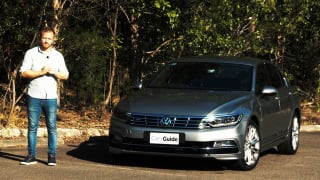
Volkswagen Passat 206TSI R-Line sedan 2017 review
Andrew Chesterton road tests and reviews the new Volkswagen Passat 206TSI R-Line sedan with specs, fuel consumption and verdict.
Browse over 9,000 car reviews
There was a time when transforming the Toyota Camry into a car that was interesting to look at and fun to drive would take a wand-waving miracle of Harry Potter proportions.
But there have been some strange goings-on at Toyota HQ lately, with the Japanese giant slowly shaking off its cardigan of conservatism and trying to produce cars that are actually, genuinely, fun to drive.
And so the first Camry range to be fully imported since 1987 (we all know by now that local production is grinding to a halt in October this year) is also the first sedan to be built on the company's 'Toyota New Global Architecture' - the same that underpins the C-HR small SUV.
The new platform joins a company-wide focus on driver enjoyment and dynamics - two things not often associated with the existing Camry.
Scheduled for an Australian launch in November, this all-new and all-imported Camry (our cars are now built in Japan) will arrive with a choice of a four-cylinder petrol, four-cylinder hybrid or V6 petrol engine and in two distinct body styles - safe or sporty.
But if you’re thinking this all sounds like more of the same, think again. Or, in the words of Toyota Australia's corporate manager of product planning, Marcus Umlauff, “Everything is different. Everything has changed.”
So has Toyota delivered the best-driving Camry ever?
| Toyota Camry 2017: RZ S.e. | |
|---|---|
| Safety rating | |
| Engine Type | 2.5L |
| Fuel Type | Regular Unleaded Petrol |
| Fuel Efficiency | 7.8L/100km |
| Seating | 5 seats |
| Price from | $19,910 |
There's two designs to choose from, standard or sporty, and both look like the current car in the same way the Hulk looks like Bruce Banner. There are similarities there, sure, but everything's gotten bigger, more distorted, and more aggressive.
The grille on the standard car, for example, which used to sit safely in the middle of the bonnet, now extends not just to the natural edges of the car, but beyond them, with the Camry taking on snowplough dimensions when viewed front-on.
Sharp creasing now carves a new shape into the bodywork, which meets a newly designed rear-end, of which the crazy squiggle of the rear lights are a particular standout.
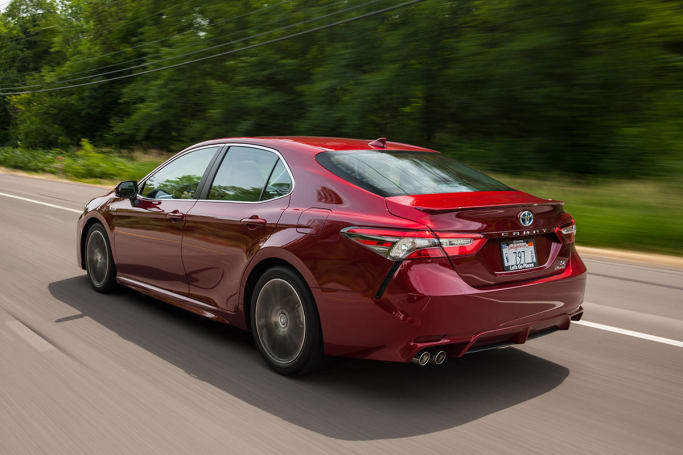
For our money, though, the Sport model is the far more resolved package. That massive grille is just the wrong side of sensible, pinched in the middle but extending out to the four corners of the bonnet, giving the Camry a proud and jutting jawline that looks more than a little like a smiling alien from Predator.
The bonnet split that frames the badge now stretches all the way to the edges of the car, joining new and thinner headlights that sweep back into the body. Viewed rear on, you'll find flared rear arches, four exhaust tips and a little spoiler on the boot lid.
Either way, though, you'll find the roof is 25mm lower, while the bonnet is now 40mm lower - both of which give Australia's most sensible car a lower, sleeker, faster profile. Very un-Camry indeed.
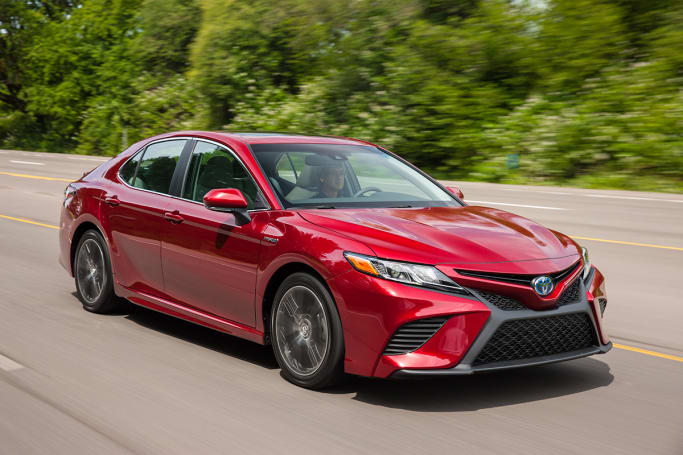
Inside, the Camry's a huge departure from the vehicles currently prowling Australian roads. Toyota's keen to shift the Camry into a more premium space, and the cabin is definitely a reflection of that.
Beyond that though, it's just kind of cool. Especially the smooth and swirling dash that looks architecturally designed, and gently points the key controls toward the driver.
Look around though, and there are still some cut-price nasties, not least of which is the hard plastic strip that houses the power-window buttons that looks like it's been transported from the early 2000s.
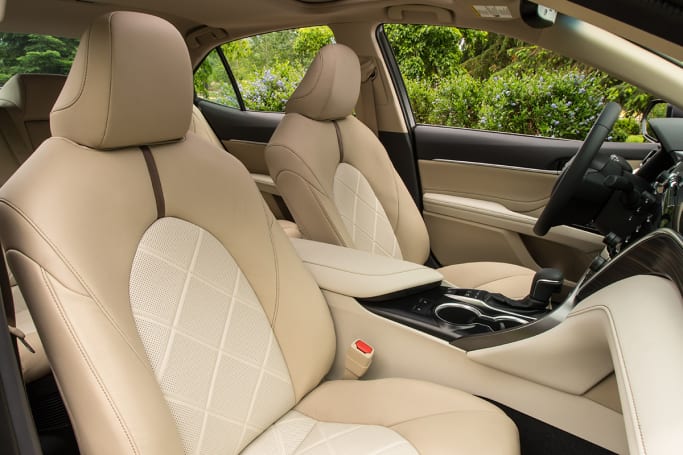
The Camry is still officially a medium-sized sedan, but its ever-growing dimensions must surely be pushing the boundaries.
This new model is between 30mm and 46mm longer overall, and the wheelbase is up 50mm, than the current model. They don't sound like massive gains, but the result is a genuinely huge cabin, especially in the backseat where legroom is impressive, even behind tall front-seat riders.
Up front, there are two cupholders in the central storage area, along with a host of USB and power sources hidden on the driver's side of the cabin. Backseat riders share another two cupholders hidden in the pull-down divider that separates the rear seat, and there's room in every door for bottles.
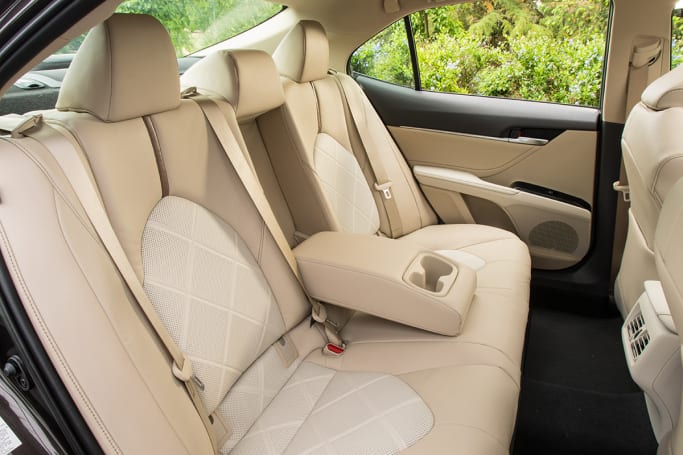
A design change has seen the hybrid battery storage shifted from the boot to under the rear seat, unlocking an extra 30 litres in storage in the spacious boot, but detailed storage information is not yet available.
While Toyota is yet to confirm any concrete pricing for the incoming Camry, the forecast is pain ahead for budget-conscious shoppers.
Toyota executives admit they have been “artificially” propping up the Australian factory by discounting the current Camry fairly heavily - a practice they'll be putting a stop to come November. The translation is that the sharp drive-way pricing deals that help shift the current model will be no more.
Toyota's executives are also keeping mum on pricing and specification details for now, but they've made no secret of their intention to shift this Camry into a more premium (and more expensive) space, and so, our cars will arrive well kitted out from a design and technology standpoint.
Inside, a 7.0- or 8.0-inch touchscreen, depending on the trim level, does miss out on Android Auto and Apple CarPlay, but has been set up to ape a traditional smartphone's layout, and will work with things like 'Hey Siri' or 'Ok Google'.
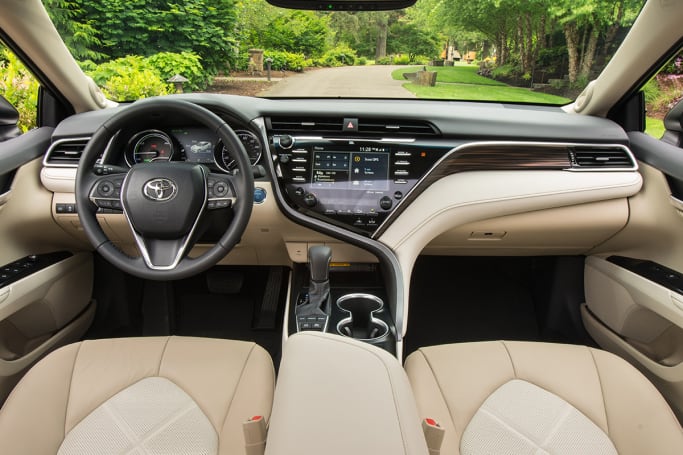
Cheaper models will get a small digital screen in the dash, while the top-tier cars will arrive equipped with a 7.0-inch TFT nestled in amongst the traditional dials.
Finally, a whopping 10.0-inch head-up display is available, too, with the extra real estate capable of beaming much more detailed information than the usual speedometer reading.
The Camry will ride on 17-, 18- or 19-inch alloys, with a space-saver spared tucked into its large boot.
The Camry will arrive with three engines, though we've only tested one, which begins with the four-cylinder, 2.5-litre entry-level petrol engine carried over from the current model, and tops out with a new V6 option that will produce 222kW at 6600rpm and 356Nm at 4700rpm, paired with an eight-speed automatic transmission.
But nestled in the middle of those two is the new hybrid unit we've tested here, which is the engine Toyota thinks will become the best-selling option in Australia - helped along by fleet sales from Government departments eager to shrink their environmental footprint.
The 2.5-litre hybrid will produce 131kW at 5700rpm and 221Nm at 5200rpm (modest enough increases on the current model), and is paired with a CVT auto. The electric motor can add as much as 88KW and 202Nm, but the hybrid set-up means maximum power from both the electric motor and petrol engine is never available all at once, and the engine's maximum output is listed at 155kW.
Fuel figures are yet to be officially confirmed for all but the hybrid engine, which will sip a miserly 4.5L/100km on the claimed combined cycle, helped by a new 'coasting' function which slips out of gear when it can (like when you're approaching a traffic light) to save fuel.
It's hard to think of a city less suited to the sensible shoe-wearing Toyota Camry than the hipster heartland of Portland, Oregon - a city filled with people that devour the weird and wonderful with the same ferocious appetite they apply to flannelette clothing and deconstructed soy lattes.
And yet it's here, in the hills 40km from the centre of town, that Toyota throws us the keys to its newest hybrid. Clearly, then, this is no ordinary Camry.
The Camry of old was all about practicality, dependability and fuel economy, but Toyota's engineers now glow with pride when they talk about a 30 per-cent increase in torsional rigidity, or the new double-wishbone rear suspension. Phrases like "lower centre of gravity" and "engaging drive" pepper the media briefing.
And while a relentless downpour, combined with fog so thick it clung to you like spiderwebs, meant truly putting this new and surprisingly agile Camry to the test was reserved for folks a whole lot braver than me, if our brief test drive on some twisting rural roads is any indication, then signs are hugely positive for this new Camry.
The revised suspension will be offered in two tunes; a softer, more billowy standard setting, and a sportier version that is right on the money in terms of striking a balance between sporty and supple, while still soaking up dodgy road surfaces with little fuss. And it's the latter than best showcases the engineering work that's gone into this new Camry.
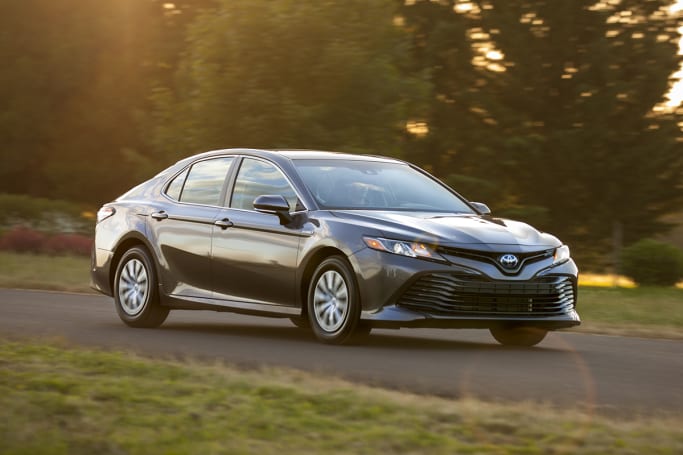
Even in the wet, when the tyres were only too happy to relinquish their grip on the road surface below, it's easy to tell that this will be the best-driving Camry yet - even if that's not the tallest mountain to climb.
Is it the sportiest, most athletic offering you could spend what will likely be $30,000 and up on? No. But that's not what its customers are likely to actually want, and it does feels connected to the road now in a way it hasn't in the past. The steering has an open line of communication with the front wheels, too, and the Camry feels agile enough in bends.
The hybrid Camry was the only vehicle available to test, but it will be joined in Australia by a V6-powered version that will make better use of these new found dynamics, and at a glance, seems more suited to Australia's palate.
But those who opt for the hybrid (and Toyota's hoping that's lots of you, given they're tipping it to become the best seller), will find it surprisingly capable of getting up to speed. Stay light with the pedal and you can waft around in a pure EV mode for limited distances, too.
But all this talk of dynamics is likely a moot point for the Camry's target audience, most of whom are are unlikely to set off in search of a mountain pass, the red mist gathering in their line of sight. Fortunately, then, the Camry remains quiet (except for the occasional drone of the CVT) and comfortable on the road in everyday driving.
And while our test drive was too brief and too wet to deliver any kind of definitive verdict, it did paint a rosy picture for the Camry's local launch in November.
Basic Warranty
3 years / 100,000 km warranty
ANCAP Safety Rating

“Safety is standard”, says a Toyota executive at the Camry's international launch. And we're happy to report that's more than just empty platitudes.
Every Camry will get seven airbags, a reversing camera and parking sensors as standard, but will also get a pre-collision warning system with AEB, active cruise control, hill start assist and lane assist with an active steering system that will tug the wheel if it senses you drifting out of your lane.
Higher-spec models will add blind spot monitoring and rear-cross traffic alert.
While specifics are yet to be confirmed, expect the Camry to be covered by Toyota's standard three-year/100,000km warranty. But in good news for customers, we're expecting the Camry to score the same service intervals as its C-HR sibling, extending the time between service centre visits to 12 months or 15,000km, instead of the six months or 10,000kms on most other Toyota cars.
Yes, it will be hard to shake the longstanding 'vanilla' reputation, and some will hate the fact it's no longer built in Australia. But those who do jump into the driver's seat of the all-new Camry will be pleasantly surprised.
| Vehicle | Specs | Price* | |
|---|---|---|---|
| RZ S.e. | 2.5L, ULP, 6 SP AUTO | $19,910 – 25,190 | 2017 Toyota Camry 2017 RZ S.e. Pricing and Specs |
| Altise Hybrid | 2.5L, Hyb/ULP, CVT AUTO | $21,560 – 27,280 | 2017 Toyota Camry 2017 Altise Hybrid Pricing and Specs |
| Altise | 2.5L, ULP, 6 SP AUTO | $18,040 – 22,880 | 2017 Toyota Camry 2017 Altise Pricing and Specs |
| Atara SX | 2.5L, ULP, 6 SP AUTO | $21,120 – 26,730 | 2017 Toyota Camry 2017 Atara SX Pricing and Specs |
| Design | 8 |
|---|---|
| Practicality | 7 |
| Price and features | 7 |
| Under the bonnet | 7 |
| Efficiency | 8 |
| Driving | 8 |
| Safety | 9 |
| Ownership | 8 |
$12,490
Lowest price, based on 198 car listings in the last 6 months